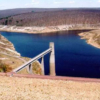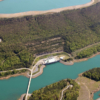Overview
The Mobile District of the United States Army Corps oversees several flood control, navigation and hydropower dams in Alabama and Georgia. Two concrete dams in particular, West Point Dam, which impounds the Chattahoochee River on the Alabama-Georgia state line and R.F. Henry Lock and Dam, on the Alabama River, in Georgia. West Point Dam was authorized for construction in 1962 by the Flood Control Act of that year and is designed to provide flood control, hydropower, navigation, wildlife habitat and recreation.
The West Point Lake created by the dam extends 35 miles upstream and provides 525 miles of shoreline for fishing, camping, boating and other recreation. Hydropower is provided by 3 generators with a maximum output of 43,000kW.
The R.F. Henry Lock and Dam impounds the Alabama River at a point 245.5 miles above its mouth. It was authorized for construction in the Flood Control Act of 1944, to provide navigation, hydropower and recreation. Navigation is provided with a lock chamber located in the left bank between the spillway and left overbank earth dike. The lock chamber is 84 feet (m) wide and 655 feet long, with a useable length of approximately 600’. Hydropower (the powerhouse retains its original name of Jones Bluff) consists of 4 generators with a total maximum output of 82,000kW.
What We Did
The spillway structures at West Point and R.F. Henry are supported with a series of anchored (utilizing pre-stressed trunion anchor rods) piers or blocks. Each pier has 2 sets of trunion rod anchor assemblies exiting the front of the pier, protected with steel covers. Over the years, hydrostatic pressure acting on the spillways has caused stress and subsequent failure of some of the trunion rods. The failure is seen by the nut and rod end of the trunion rod assembly separating from the pier. The protective covers must be removed to identify these failures.
Due to the difficultly of cataloging these rod failures the Army Corps awarded a contract to us to design and install a monitoring system for both projects to automatically and remotely monitor these failures. The monitoring was facilitated by installing accelerometers on the covers (view shown at right) and reading them 100x per second and developing an algorithm to identify when failures occur. Failure of the trunion rods produce a rod and nut projectile which strikes the steel cover which is monitored by the accelerometer.
Monitoring with Loggers
Monitoring is undertaken by Campbell Scientific CR800 dataloggers (view shown at right) mounted in protective enclosures on the railing above the piers. Each logger is battery powered with solar recharging and a radio. Base stations mounted in the control rooms, consisting of Campbell Scientific CR850’s and radio, interrogate the remote stations every 15 minutes and set a status light and relay if a pier shows a failed rod. Each pier has a corresponding light and relay so the specific pier that shows a failure can be investigated by the Corps personnel. The relays are also read by the Corps Supervisory Control and Data Acquisition (SCADA) systems at each dam to allow immediate notification of Corps personnel.
Our MultiLogger Suite software provides for programming the stations and collecting the analyzing the captured waveform data.


